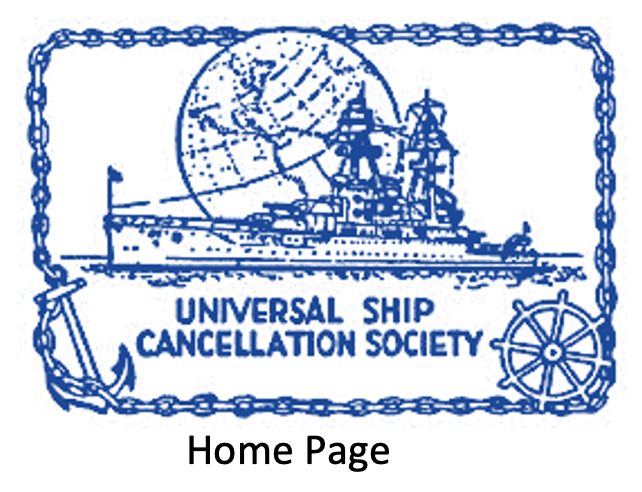A SURVEY OF NAVAL COVER ART
Exhibited by Robert Rawlins (USCS 5490)
This exhibit has received the following awards:
Gold Medal Americover 2005
AAPE Award for Creativity
Gold Medal Americover 2004
U.S.C.S. Fernandez Award (Best in Show)
Synopsis
The exhibit will be on display in the Illustrated Mail Section at APS Winter Show Atlanta February 18-20, 2005
Cachets on naval covers are known before 1930, but the practice did not really take off until the formation of the Universal Ship Cancellation Society in 1932, the 1931-34 cruise of USS CONSTITUTION and formation of the American Naval Cover Society in 1935. By the end of 1941, between 750 and 1,000 individuals and chapters were sponsoring cacheted naval covers.
This exhibitor has been accumulating cacheted covers for 34 years, a collection which formed the basis for the referenced publication. Of course, other USCS members aided in filling in many of the details in the publication.
This exhibit provides a wide ranging look at the many varieties of cachets which have appeared over the years on naval covers as well as the topics chosen for cachets. The exhibit is heavy on the 1930-1941 covers, without question the “golden age” of naval cacheted covers. During that time approximately 30% of the members of the two naval cover societies noted above were personnel, many in ships, and cooperation with sponsors was at its highest ever.
To my knowledge, an exhibit of this scope and reach has never been attempted.
Scope: The exhibit illustrates every technique for preparing a cachet that I have encountered in over 30 years of search. In addition to those mentioned on the title page, the hand done sections illustrate silk screen, air brush, wood and linoleum block, calligraphy, embossed, applique, hand written, pencil, colored pencil, pen and ink plain and tinted, oil, acrylics, gouache, poster paint and water colors, on silk, combinations thereof and various materials used as envelope stock.
In addition, a wide range of cachet subjects and sponsors are both included in the scope of the exhibit.
I have chosen to include examples of poorly executed cachets for the simple reason that not all cachet art is uniformly excellent or pleasing to the eye.
Condition: Unfortunately, many sponsors elected to use low cost envelopes containing various impurities resulting in toned envelopes after all these years. This was especially true during the depression years but continues even today. Toned envelopes are thus a fact of life.
Scarcity: Cacheted naval covers produced by mechanical means were usually issued in quantities of about one hundred to thousands. However, hand done cacheted covers were generally issued in small quantity. Often, members sent birthday and holiday greetings to each other by way of cacheted covers; thus, some of the illustrated covers may well be one of a kind. Records of quantity produced were seldom kept, so it is hard to tell, but many of the hand done covers in the exhibit are the only ones I have every found. Most pages have two covers mounted; covers mounted one to a page are thought to be one of a kind or one of very few.
Highlights:
The earliest recorded cachets on naval cover are illustrated in frames 1 and 6.
Covers demonstrating alignment of two separate cachets to produce a composite, frame 1 (Nautilus).
Original art work and finished covers are found in frame 2 (Permit), frame 3(Snapper) and 10 (Nimitz); covers with a base and the finished design in frame 9 (Reynolds and Seath). Variants executing the same design are in frame 7 (Weigand).
The “Our Navy” cover in frame 8 is hand made and surely one of one. Many other hand made envelopes are contained in frames 8 and 9.
Reference:
The U.S. Naval Cover Cachet Makers’ Catalog provides background on many of the cachet makers included in this exhibit.
Click on the thumbnails to see a full size image.
FRAME ONE
Rubber Stamp Cachets
FRAME TWO
Printed Cachets
FRAME THREE
Thermographed and Typed Cachets
FRAME FOUR
Embossed, Transfer, Engraved, Mimeograph, and Hectograph Cachets
FRAME FIVE
Label, Photo, and Blocked Cachets
FRAME SIX
Hand Done Cachets – Pencil, Pen & Ink
FRAME TEN
Hand Done and Computer Generated Cachets
